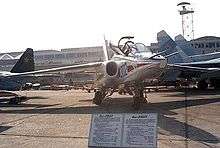Sukhoi Su-28
The Sukhoi Su-28 is a downgraded variant of the Su-25UB / Su-25T, with reductions in avionics and aircraft systems, together with the elimination of all weapon-carrying capability. The Su-28 trainer is intended for technical skill, general flight and formation flying training. It is also used as an aerobatic aircraft
| Su-28 | |
|---|---|
| Role | Trainer |
| Manufacturer | Sukhoi |
| First flight | 1987 |
| Primary user | Russian Air Force |
| Developed from | Sukhoi Su-25 |
Design and development
The Su-28 is a highly maneuverable and robust aircraft with the ability to perform take-off and landing with only one of its two engines running. The aircraft's engines can also run on a diesel based fuel as opposed to more traditional aviation fuel. Like the MiG-29, it also has the ability to operate from unpaved runways while maintaining high reliability and a low maintenance requirement. In addition, the Su-28 can withstand heavy landings, allowing it to be more forgiving in the training role. Range can be extended by up to four PTB-800 drop tanks, each of 800 L capacity.
Differences between the Su-28 and its parent Su-25UB model include the absence of targeting systems, weapon-operating systems, internal guns, wing pylons (used on military aircraft to mount weaponry such as bombs and missiles). It also lacks armor protection for the engines, electronic countermeasures and any systems dedicated to ground attack operations.

Specifications (Su-28)
Data from
General characteristics
- Crew: 2
- Length: 15.36 m (50 ft 5 in)
- Wingspan: 14.36 m (47 ft 1 in)
- Height: 4.8 m (15 ft 9 in)
- Wing area: 33.7 m2 (363 sq ft)
- Empty weight: 4,500 kg (9,921 lb)
- Gross weight: 12,000 kg (26,455 lb)
- Max takeoff weight: 17,222 kg (37,968 lb)
- Fuel capacity: 2,750 kg (6,063 lb) internal + 4 × 1,150 kg (2,535 lb) drop tanks
- Powerplant: 2 × Tumansky TRD R-95Sh turbofan engines, 40 kN (9,000 lbf) thrust each
Performance
- Maximum speed: 950 km/h (590 mph, 510 kn)
- Range: 1,000 km (620 mi, 540 nmi)
- Service ceiling: 7,000 m (23,000 ft)
- g limits: +6